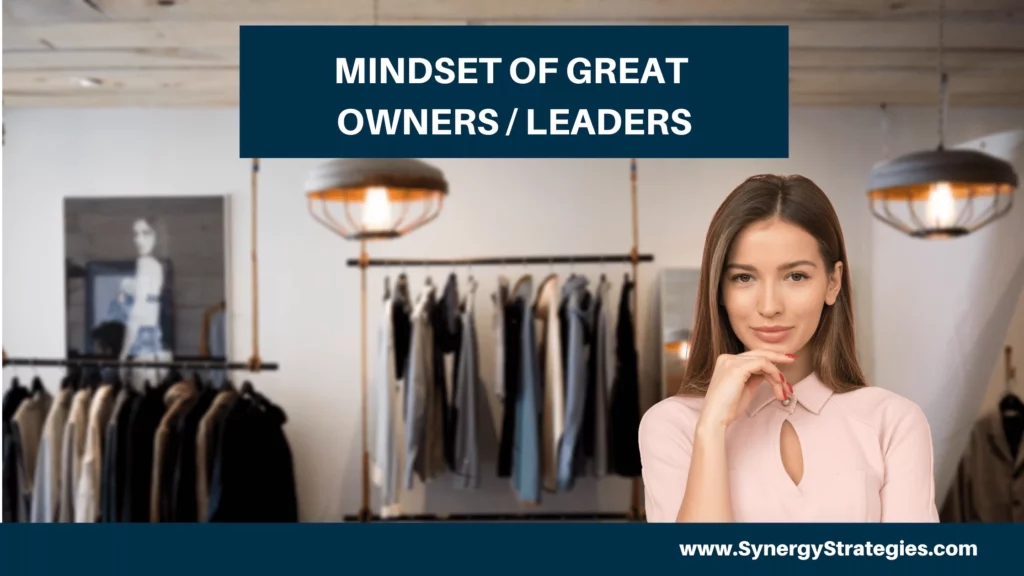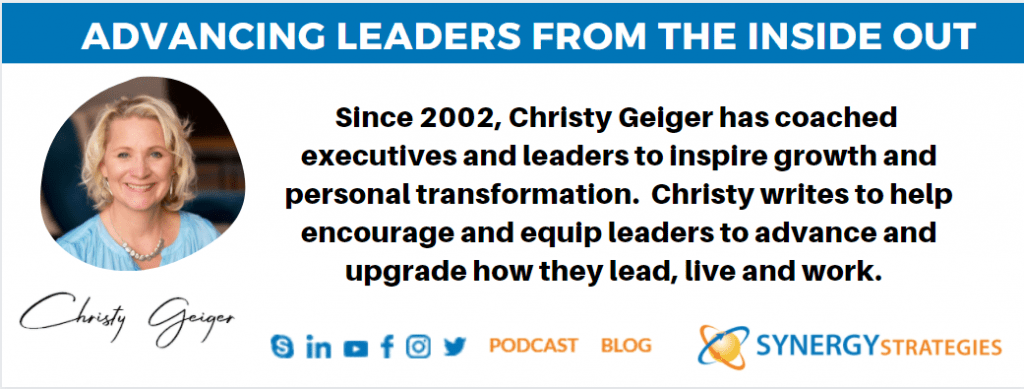As an owner of a business sometimes we want our team to think like owners but realize they have a different perspective as a member of the team. As leaders grow in an organization, having the “mindset of an owner” becomes important for them to lead and represent the organization. Here are a few ways to think like an owner for leaders. Owners/leaders ….
- Decisions: Make tough and unpopular decisions. The team may not respect, understand, or agree with the decision. Owners must be willing to take the backlash even when the team responds emotionally negatively. They must always make decisions holding the bigger picture (what is best for the team, organization, and sustainability).
- Communication: Deliver tough or unpopular messages. Much like decision-making, an owner must have conversations that can be uncomfortable and challenging. They must be clear on why they made the decision and be emotionally mature and grounded to have conversations that help others to understand. An owner is aware of the balance between too much information which is not appropriate and muddies the water and too little information which breeds questions, water cooler gossip, and misunderstandings. When talking with the team, an owner is heart-centric for the people they are leading. They are sensitive to how the news will impact them while being clear, steadfast, and honest about the information (not sugar-coating, making the communication squishy or evasive).
- Work Ethic: Are willing to work as needed. Owners might be called to work nights, weekends, early mornings, AKA: off-hours, etc. Be aware of two ditches. First, the ditch of entitlement which leads an owner to not work off hours because they have a team they make do it. Second, is the ditch of burnout, working off-hours, burning themselves and their team out. It is not about a lack of balance, planning, or discretion. It is about commitment, thoroughness, responsiveness, and urgency. An owner can prioritize what needs to be done now versus later. They are not a bottleneck for information or communication that is needed to empower, equip, and support others. Often owners work between the cracks of life – meaning when there is the 5-10 min of downtime, rather than being on social media, reading the news, or playing a game – they are moving something forward and advancing the mission they are on.
- Curious: Ask questions vs. just pushing their idea. Owners must constantly be gathering information, perspective, and risk-cost ratios. They ask questions to understand where people are at, what people are thinking, seeing, and feeling. They size up what is needed based on the mission, goals, and needs of the organization and customers they serve. Owners gain influence and build consensus – not by telling, but by seeking to understand before seeking to be understood, by sharing the “Why” and the bigger picture, and by being aware and considering the ramifications and ripple impact of a decision. Owners ask for and take feedback. They are others centric, leading forward while integrating as many win-wins as possible (but not sinking to pleasing at the expense of the mission, compromising that dilutes the mission, or delaying action). Owners seek to include and help people feel heard and valued while helping people to see the mission, so decisions and directions are more supported and understood.
- Big Picture: Filter feedback and suggestions with the direction of the mission/goal. Decisions are filtered through the big picture. The big picture includes the business’ goals as well as the importance of the team and the people that are part of the team. It understands a dying business is not useful to anyone, therefore owners hold the business goals, sustainability, and health of the organization clearly while listening to the many voices, needs, and desires. There are significant and giant decisions owners make. An owner might be tempted to decide from a place that has a selfish motive, feels easy, is fear reactive, or is self-profiting ($, time, work, etc.). These all result in issues and negative impacts, erosion of trust, culture, and company wellbeing. Owners look what is best for all (company, people, culture, etc.) over what is best for them. The owner’s life is often one of sacrifice and service. Yes, there are owner benefits, however, the proportionate volume of a great owner/leader is that owner has put much more on the line in time, dollars, investment, ideas, risk, and sacrifice so that the company could be born, grow and flourish. When owners shift to a “taking” posture that trumps the “giving” service and advancement of company health and wellbeing, companies often struggle.
- Helicopter: Get out of the trench and in the high-level and vision headspace. Many owners work in the trench, visit the trench, and address the trench. As a result, an owner must prioritize time in the helicopter (looking at vision and the bigger picture). No one is screaming for you to get in the helicopter until the direction of your business wavers. The trench is where your team is hard at work. They have questions, needs, and demands. It can be challenging to not get consumed and stuck in the trench. The challenge is to recognize the owner’s “job” is more in the helicopter to see the vision, direction, future, anticipated obstacles, and issues to head off, so it doesn’t slow the trench down. The helicopter gets to see the impact of the trench and needs to affirm, applaud, and celebrate the wins of the trench. The helicopter must be a compass and guide for direction and activity. When an owner is in the helicopter, they can see and assess. Therefore, owner communication is so important because the trench needs information, feedback, and direction. It is not telling them what to do but co-creating and designing the next steps based on what you see from this unique vantage point.
- Emotional Intelligence (EI): Constantly grow their EI to lead better. Owners must constantly level up their EI, so they are about to filter themselves. It is not because you are being disingenuous, fake, or conforming but realizing you have impact, influence, and reflect more than your own opinion. As a leader of an organization your words represent the organization and the people you represent. Think of it like you have a billboard reality and face. Owners must realize what they say is not about them or hiding what they think or believe, but rather an emotional awareness of what you stir and activate and create in others. This is where owners can lead up or lead down. If you lead up, you call people to a higher level and way of thinking, if you lead down, you distract people’s minds with lower-level thinking, stories, and emotions that disrupt their energy, emotions, and work. As humans, we get triggered in many ways, but as leaders, we can be responsible for HOW we say things to do it in a skillful way that advances critical thinking and problem solving rather than creating anger, confusion, or injustice. Owners/leaders have a level of responsibility to filter the full spectrum of how their words would be taken, felt, or received. Therefore, EI matters. When a leader has a good level of, self-regard (confidence), self-awareness, self-actualization (growth mindset), empathy, and optimism they can communicate in a way that is heartfelt, honest, and inclusive rather than messages that create divisiveness and exclusivity. As owners are responsible for the impact and influence, they have on others, they are better able to not trigger, exclude, shut people down, project ego or arrogance (I’m right your wrong). This is critical because this lack of great EI communication is often where leaders unintentionally erode and suffocate trust and suppress creating the safe place they want for their workplace.
- Proactive: Are vigilant of what is seen or unseen that could have a negative impact and adjust to ensure a positive and aligned course. They are alert, pay attention, and sense the energy and mood of the team and culture. They use common sense and proactive measures to consider the risk-reward of things that are happening or might be happening. They don’t wait to be told. They are always mindful and looking, not in a paranoid or suspicious way, but rather as part of their job and responsibility to be aware of threats to the team, customer, or company/mission. They look for red flags, potholes and smell out things that might be off. These invisible but toxic activities that happen in the workplace usually leave a trail and clues if owners are paying attention. Great owners are always tuned into this because toxic things tank and impact the culture they have worked so hard to create. They create unnecessary and challenging distractions from the important work and mission the group is on. The owner knows part of their work is maintaining the integrity of the experience they originally created and are evolving. Toxic issues are detractors and derailers. Owners are vigilant to always have a 3rd eye watching for them as they go about their work. If there is anything that seems off, owners are proactive and intentional to act, always bringing things into alignment with the mission and direction of the company. They are forthwith to bring up issues with leadership, discuss gaps, communicate, and adjust to advance the integrity of the company and mission.
Quick filter for signs of owner who is more employee mindset (even if you are the owner or leader):
- Victim (feeling scarcity, what the company needs to do for me or others, lack of enough, etc.)
- Immature (unable to handle emotions and feelings without blasting and verbal vomiting versus a mature conversation)
- Me first (thinking about personal desires vs. others first and company impact/sustainability) (meaning there are lots of things we would like to but must be affordable, sustainable, etc.)
- Power & Control (feeling less and just desiring power, control, and a voice to get my way rather than seeing the bigger picture)
These mindsets matter and contribute to a company that is people-centered and a positive force in the world. As owners and leaders, we can constantly be growing our EI and self-awareness so we can adjust and lead well for the sake of the people we lead and the mission we desire to advance.






